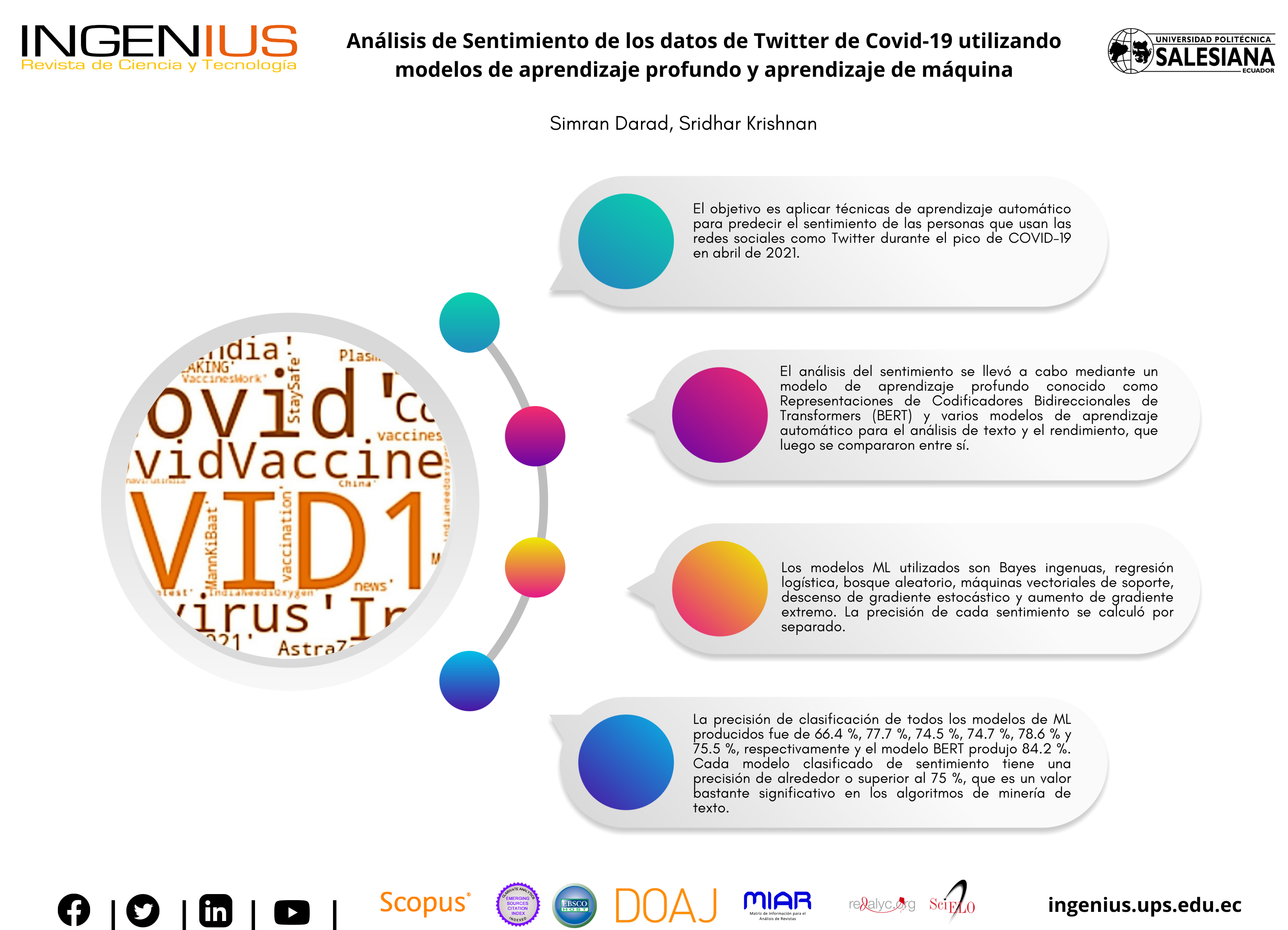Sentimental analysis of COVID-19 twitter data using deep learning and machine learning models
Main Article Content
Abstract
Keywords
COVID-19, coronavirus, twitter, tweets, análisis de los sentimientos, tweepy, clasificación de texto COVID-19, coronavirus, Twitter, tweets, sentiment analysis, tweepy, text classification
References
[2] M. Mansoor, K. Gurumurthy, A. R. U, and V. R. B. Prasad, “Global sentiment analysis of COVID-19 tweets over time,” CoRR, vol. abs/2010.14234, 2020. [Online]. Available: https://doi.org/10.48550/arXiv.2010.14234
[3] H. Drias and Y. Drias, “Mining twitter data on covid-19 for sentiment analysis and frequent patterns discovery,” medRxiv, 2020. [Online]. Available: https://doi.org/10.1101/2020.05.08.20090464
[4] F. Rustam, M. Khalid, W. Aslam, V. Rupapara, A. Mehmood, and G. S. Choi, “A performance comparison of supervised machine learning models for covid-19 tweets sentiment analysis,” PLOS ONE, vol. 16, no. 2, pp. 1–23, 02 2021. [Online]. Available: https://doi.org/10.1371/journal.pone.0245909
[5] R. Lamsal, “Design and analysis of a large-scale COVID-19 tweets dataset,” Applied Intelligence, vol. 51, no. 5, pp. 2790–2804, May 2021. [Online]. Available: https://doi.org/10.1007/s10489-020-02029-z
[6] A. D. Dubey, “Twitter sentiment analysis during covid-19 outbreak,” SSRN, 2021. [Online]. Available: https://dx.doi.org/10.2139/ssrn.3572023
[7] N. Chintalapudi, G. Battineni, and F. Amenta, “Sentimental analysis of COVID-19 tweets using deep learning models,” Infect Dis Rep, vol. 13, no. 2, pp. 329–339, Apr. 2021. [Online]. Available: https://doi.org/10.3390/idr13020032
[8] M. A. Kausar, A. Soosaimanickam, and M. Nasar, “Public sentiment analysis on twitter data during covid-19 outbreak,” International Journal of Advanced Computer Science and Applications, vol. 12, no. 2, 2021. [Online]. Available: http://dx.doi.org/10.14569/IJACSA.2021.0120252
[9] A. Mitra and S. Bose, “Decoding Twitter-verse: An analytical sentiment analysis on Twitter on COVID-19 in india,” Impact of Covid 19 on Media and Entertainment, 2020. [Online]. Available: https://bit.ly/3YMj1c3
[10] B. P. Pokharel, “Twitter sentiment analysis during covid-19 outbreak in nepal,” SSRN, 2020. [Online]. Available: https://dx.doi.org/10.2139/ssrn.3624719
[11] C. R. Machuca, C. Gallardo, and R. M. Toasa, “Twitter sentiment analysis on coronavirus: Machine learning approach,” Journal of Physics: Conference Series, vol. 1828, no. 1, p. 012104, feb 2021. [Online]. Available: https://dx.doi.org/10.1088/1742-6596/1828/1/012104
[12] S. Boon-Itt and Y. Skunkan, “Public perception of the COVID-19 pandemic on twitter: Sentiment analysis and topic modeling study,” JMIR Public Health Surveill, vol. 6, no. 4, p. e21978, Nov. 2020. [Online]. Available: https://doi.org/10.2196/21978
[13] A. K. Uysal and S. Gunal, “The impact of preprocessing on text classification,” Information Processing & Management, vol. 50, no. 1, pp. 104–112, 2014. [Online]. Available: https://doi.org/10.1016/j.ipm.2013.08.006
[14] S. Gujral, “Sentiment analysis: Predicting sentiment of COVID-19 tweets,” Analytics Vidhya, 2021. [Online]. Available: https://bit.ly/3j9tMVj
[15] ——, “Amazon product review sentiment analysis using bert,” Analytics Vidhya, 2021. [Online]. Available: https://bit.ly/3Vad9WE
[16] B. Lutkevich. (2022) Bert language model. TechTarget Enterprise Al. [Online]. Available: https://bit.ly/3Wo5Pb4
[17] J. Samuel, G. G. M. N. Ali, M. M. Rahman, E. Esawi, and Y. Samuel, “Covid-19 public sentiment insights and machine learning for tweets classification,” Information, vol. 11, no. 6, 2020. [Online]. Available: https://doi.org/10.3390/info11060314




